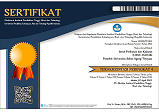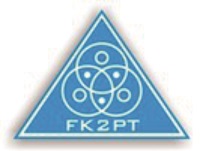DC Converter Experiment on Cu-Zn Seawater Battery for Fishing Lamp Energy Source of Lift Net Fisheries
Abstract
Keywords
Full Text:
PDFReferences
Yu K, H-Q Xiong, L Wen, Y-L. Dai, S-H Yang, S-F Fan, F Teng, X-Y Qiao. 2015. Discharge Behavior and Electrochemical Properties of Mg-Al-Sn Alloy Anode for Seawater Activated Battery. Transactiono of Nonferrous Metals Society of China. 25: 1234-1240.
Mandal B, A Sirkar, A Shau, P De, P Ray. 2012. Effects of Geometry of Electrodes and Pulsating DC Input on Water Splitting for Production of Hydrogen. International Journal of Renewable Energy Research. 2: 99-102.
Susanto A., M. S. Baskoro , S. H. Wisudo, M. Riyanto, F. Purwangka. 2017. Performance of Zn-Cu and Al-Cu Electrodes in Seawater Battery at Different Distance and Surface Area. International Journal of Renewable Energy Research. 7: 288-303.
Hongyang Z, B Pei, J Dongying. 2009. Electrochemical Performance of Magnesium Alloy and Its Application on The Sea Water Battery. Journal of Environmental Sciences. Supplement: S88–S91.
Lai MF, ND G Anh, JZ Gao, HY Ma, HY Lee. 2015. Design of Multi Segmented Freeform Lens for LED Fishing/Working Lamp with High Efficiency. Applied Optics. 54: 69-74.
McHenry MP, D Doepel, BO Onyango, UL Opara. 2014. Small-Scale Portable Photovoltaic Battery-LED Systems with Submersible LED Units to Replace Kerosene-Based Artisanal Fishing Lamps for sub-Saharan African Lakes. Renewable Energy. 62:276-284.
de Souza JPI, W Vielstich. 2010. Seawater Alluminium/Air Cells in Handbook Of Fuel Cells –Fundamentals, Technology AND Applications. Edited by Wolf Vielstich, Hubert A. Gasteiger, Arnold Lamm and Harumi YokokawaJohn Wiley & Sons, Ltd. pp 1-7. Ch 1.
Mursyidah, Susanto A dan Isnaeni BS. 2013. The utilization of sea water in a especially designed battery (sabrine swall battery). ASEAN J of System Engineering. 1(1):1-7.
Mourant A. 2016. Next Generation Batteries will Power Up The Energy Storage Industry. Renewable Energy Focus. 17(1): 41-43. DOI:10.1016/j.ref.2015.11.004.
Park S, B SenthilKumar, K Kim, SM Hwang, Y Kim. 2016. Saltwater as The Energy Source for Low Cost, Safe Rechargeable Batteries. Journal Material Chemistery A. 4(19):7207-7213.
Liu Z, Lee H. 2015, Design of High-Performance Integrated Dimmable LED Driver for High-Brightness Solid-State Lighting Applications. International Journal of Analog Integrated Circuits and Signal Processing. 82(3): 519–532.
Budisusila EN, Arifin B. 2017. Joule-Thief Circuit Performance for Electricity Energy Saving of Emergency Lamps. IOP Conf. Series: Materials Science and Engineering 190: 1-6.
Garshol T, Hasvold O.. 1995. Galvanic Seawater Cell. US Patent 5,427,871, Juny 27.
Rehman Z, I Al-Bahadly, S Mukhopadhyay. 2015. Multiinput DC–DC Converters in Renewable Energy Applications - An Overview. Renewable and Sustainable Energy Reviews: 14: 521–539.
Oekerman JB. 1969. Seawater Battery Having Magnesium or Zinc Anode and Manganese Dioxide Cathode. US Patent 3,433,678, March 18.
Hasvold O. 1995. Seawater Cell with Increased Efficiency. U.S. Patent 5 405 717, Apr. 11.
Kobashi H, Oshitani M. 2013. Seawater Activated Batteries: Magnesium. Encyclopedia of Electrochemical Power Sources: 156-163.
DOI: http://dx.doi.org/10.33512/jpk.v8i1.3680
Refbacks
- There are currently no refbacks.



_-_Copy1.png)